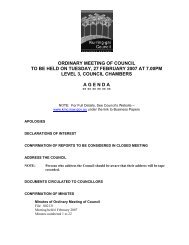Ku-ring-gai Heritage Conservation Areas North Inventory Sheet
Ku-ring-gai Heritage Conservation Areas North Inventory Sheet
Ku-ring-gai Heritage Conservation Areas North Inventory Sheet
You also want an ePaper? Increase the reach of your titles
YUMPU automatically turns print PDFs into web optimized ePapers that Google loves.
<strong>Ku</strong>-<strong>ring</strong>-<strong>gai</strong><br />
<strong>Heritage</strong> <strong>Conservation</strong> <strong>Areas</strong> <strong>North</strong> <strong>Inventory</strong> <strong>Sheet</strong><br />
Roseburn (aka Virginia Lodge), 23 Pibrac Avenue, 1900, architect Howard Joseland, designed for<br />
George Gillespie of Gillespie Bros proprietors of Anchor flour mills<br />
Kooyong (originally Upton Gray), 55 Hastings Road, 1894, architect John Sulman, designed for John<br />
Gillespie of Gillespie Bros., proprietors of Anchor flour mills<br />
Wirepe, 69 Hastings Road, 1893, designed by architect Maurice B. Halligan for Walter Windeyer<br />
Traill, also an architect.<br />
Sp<strong>ring</strong>wood, 34 Hastings Road, 1919, designed by architects Wilson Neave & Berry for cricketer T.<br />
W. Garrett.<br />
Cheddington, 52 Hastings Road, c. 1890, architect John Horbury Hunt, built for Francis Gerard,<br />
business partner in a pastoralist’s agency with Frederick Eccleston du Faur (1st owner of Pibrac),<br />
and auctioneer and friend of J.C. Remington (2nd owner of Pibrac)<br />
Warrawee <strong>Heritage</strong> <strong>Conservation</strong> Area has a diverse subdivision pattern created by subdivision and<br />
resubdivision over time, resulting in a variety of lot sizes and shapes, including battleaxe alotments.<br />
Battleaxe alotments along Hastings Road date from as early as 1907. The topography is generally<br />
gently sloping and streets vary in width, Cherry Street (originally known as Cherry Lane) and<br />
Hastings Road and the western end of Pibrace Avenue being particularly narrow. There are no<br />
formal avenues of street trees within the area, however there are mature street trees in street verges<br />
along the wider streets (eg. Bangalla Street) and elsewhere generous gardens with large mature<br />
trees with canopies extending over the street give an urban forest appearance to the area.<br />
Houses are set within generous gardens, in some cases to the extent where houses are barely<br />
visible from the street (examples are the heritage items Kooyong at 55 Hastings Road and<br />
Cheddington at 52 Hastings Road): this is more typical of earlier houses within the area (built from c.<br />
1890). Inter-war period houses are frequently two storeys, with generous setbacks, and viewable<br />
from the street. The majority of the area contains fine large houses dating from 1890-1940s,<br />
however Young Street and Raymond Avenue contain some more modest houses.<br />
Architectural styles which are featured within the area are Federation Queen Anne, Federation Arts<br />
& Crafts, two <strong>North</strong> American stick & shingle style houses designed by architect J. Horbury Hunt<br />
(Pibrac and Cheddington), Inter-war styles including Georgian revival, Old English, Mediterranean,<br />
Functionalist, California Bungalow and Free Classical, many of the houses in these styles having<br />
been architect-designed.<br />
Pibrac Avenue has a distinctive enclosed character, and while new houses now feature on the<br />
western side (from 2C-4), the remainder of the Avenue is an enclave of substantial fine houses<br />
dating from the 1890s to the Inter-war period and including some of the most significant houses in<br />
the area (for example Kooyong, Pibrac, Roseburn).<br />
Wall finishes are brick or rendered or stuccoed brick, roofs are usually slate, terracotta tile or terracotta<br />
shingled; windows are usually timber framed and vertically proportioned, however some Inter-war Functionalist<br />
style houses feature steel-framed windows, including corner or curved bay windows, with horizontal glazing<br />
bars. Original fences in the Federation period are often brick with wrought iron or timber picket, up to 1.6m in<br />
height, Inter war period fencing is generally low brick or rendered brick up to 1.2m in height. Hedging is a<br />
common feature and its use with traditional fencing, instead of high brush fencing, should be encouraged.<br />
KU-RING-GAI HERITAGE CONSERVATION AREAS NORTH INVENTORY

















